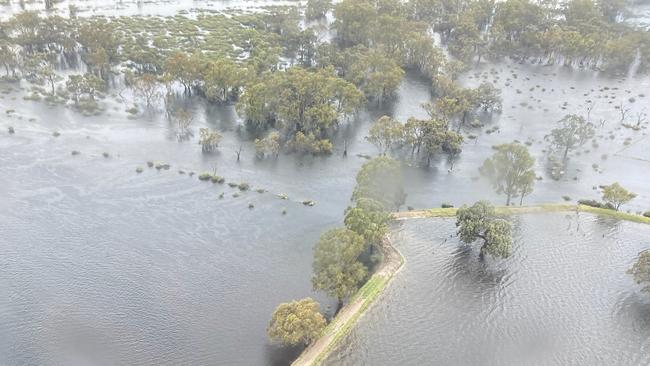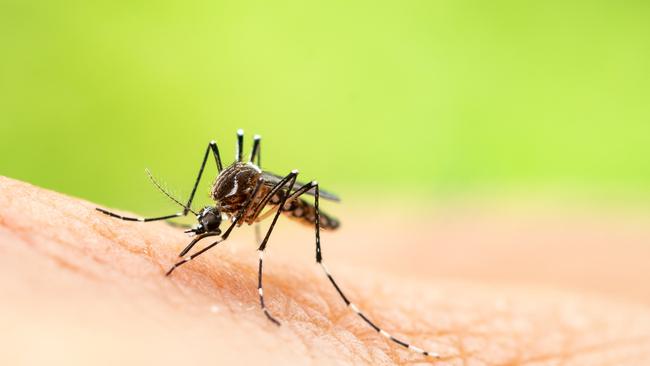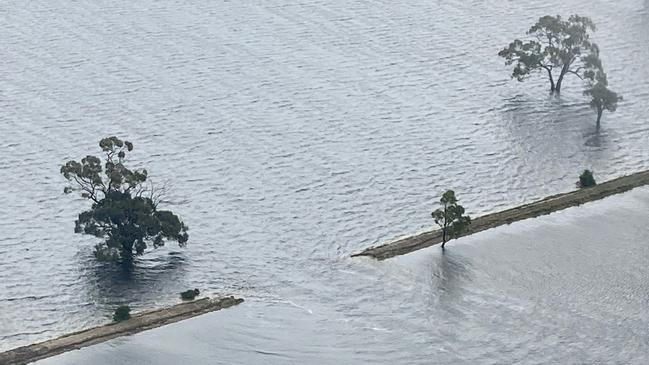‘Extreme concern’: Flooded towns face threat of severe disease
Australia has 110,000 Japanese encephalitis vaccines but 750,000 people may be at risk of infection as flooding leaves stagnant water across NSW and Victoria.

In flooded towns along the Central Murray, emergency services are managing a risk they haven’t experienced before: the potential spread of deadly-mosquito borne diseases.
But with a stockpile of just 110,000 vaccines available for the deadly Japanese encephalitis virus, states earlier this year introduced strict eligibility criteria for access to a jab.
In October, experts expressed “extreme concern” 750,000 Australians could be at risk of infection.
On Friday, NSW and Victoria responded by expanding access to the vaccine to anyone who spends more than four hours a day outside in a list of “high risk” LGAs — with the exception of infants under two months old.
In NSW, 39 LGAs covering the majority of the Murray-Darling Basin are considered high risk.
In Victoria, the LGAs of Wangaratta, Strathbogie and Benalla were on Friday added to a list of high risk LGAs that includes Campaspe, Gannawarra, Greater Shepparton, Indigo, Loddon, Mildura, Moira, Swan Hill, Wodonga and Towong.
Victoria’s deputy chief health officer associate professor Deborah Friedman said widespread flooding had prompted authorities to expand access to the vaccine.
“We know mosquitoes don’t breed in initial flood waters, but that the risk increases as these waters recede and leave behind pools of stagnant water,” Ms Friedman said.
Bordered in the north by the swollen Murray River and in the south by the flooded Loddon River, the Victorian towns of Benjeroop and Murrabit are one region now surrounded by stagnant water that will take months to drain.
The experience isn’t a new one for locals, who were flooded in to their homes for months following floods in 2011.
But local Country Fire Association commander Michael Masters said the public health risk of mosquito-borne diseases was a new challenge that was “at the forefront of people’s minds”.

This is the first year authorities are contending with the potential spread of Japanese encephalitis, which was detected for the first time in NSW in late February 2022.
By July, the virus was found to have infected one in every 11 people in five regional towns in the Murray Darling Basin, stretching as far south as Corowa and as far north as Dubbo.
By October, there had been 30 confirmed human cases and six deaths from the virus across Australia’s east coast. To date, there have been no confirmed cases in Victoria.
The QIMR Berghofer Medical Research Institute issued a statement in October expressing “extreme concern” over the risk of Japanese encephalitis spread this summer.
Associate professor Greg Devine warned as many as 750,000 Australians could be at risk of exposure as flooding created new wetlands that became breeding grounds for the vector mosquito Culex annulirostris.
While most people infected with Japanese encephalitis have no symptoms, one in 250 people can become severely unwell and may either develop a permanent disability or die.

A spokesperson for the federal Department of Health and Aged Care said the commonwealth had purchased 130,000 doses of Japanese encephalitis vaccines in early 2022, of which at least 23,293 had been administered by November 2.
Beechworth GP and Murray Public Health Network medical adviser Dr Wendy Connor said she was administering on average two to three jabs per week at her clinic.
“At the moment, vaccines are available to us and we are getting them in.
“If it were to become a major outbreak, we would be quite short of vaccine,” she said.
While the small GP practice had capacity to offer the vaccine at the moment given low demand, “if it became a universal vaccination campaign that would be a different story,” Dr Connor said.
The Weekly Times asked the Department of Health and Aged Care if more vaccines had been ordered. The department did not respond to the question, but said “Japanese encephalitis vaccines are in limited stock internationally, requiring access to be prioritised.”

The Department urged people to protect themselves from mosquito bites.
“Bite-avoidance remains a key prevention strategy for all mosquito-borne diseases,” it said in a statement.
But for people in low-lying Murray River towns, that won’t be an easy task.
In Benjeroop’s last major flood in 2011, flood warden Lesley Schultz said he boated in and out of his property for four to five months as water drained slowly from the low-lying country.
“We won’t get the water out of Murrabit West and Benjeroop until the big river drops. I boated in and out for four and a half months back in 2011, and I can’t see it being any quicker than that now,” Mr Schultz said.
CFA commander Michael Masters said emergency services were balancing the need to protect downstream communities from rising floodwater with the need to move stagnant water away from towns as quickly as possible.
“We’re being proactive in trying to get that water moved before it becomes breeding grounds for significant mosquito numbers.
“As a firefighter, I never thought that I’d be having to manage or consider an issue around such significant public health matters,” he said.
In addition to Japanese encephalitis, the mosquito-borne diseases Ross River fever and Murray Valley encephalitis have the ability to cause long-term illness, and there is no prevention available for them at present.




